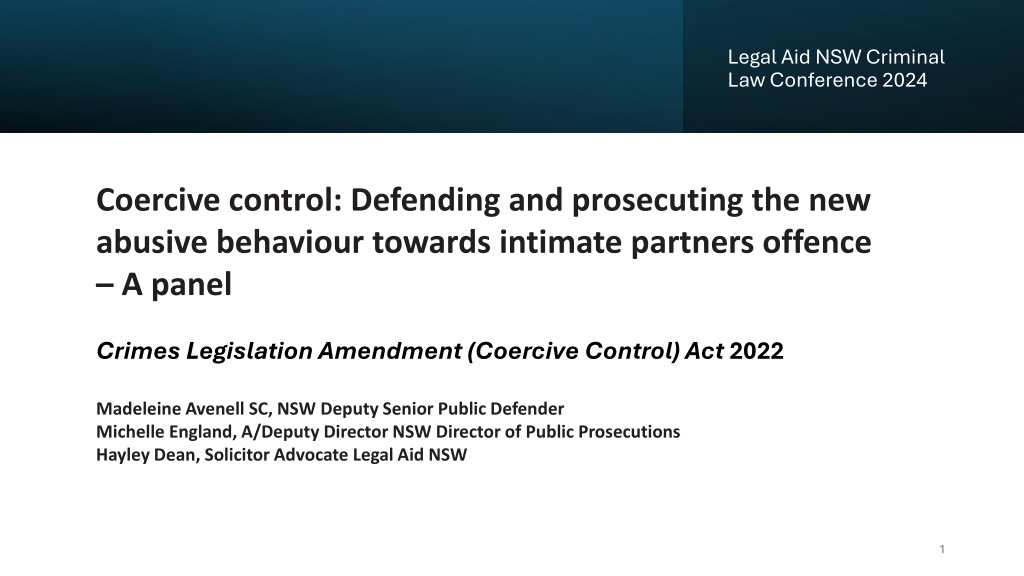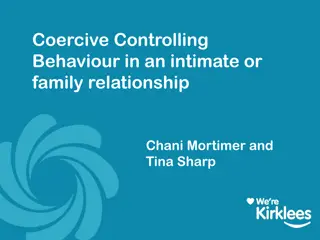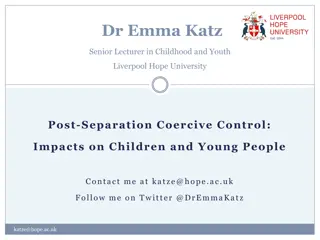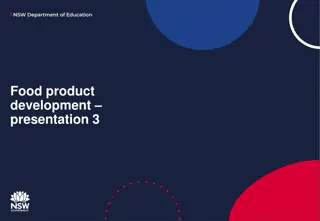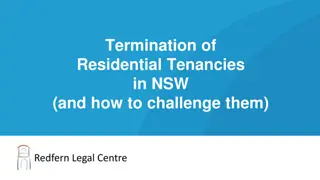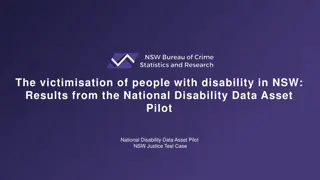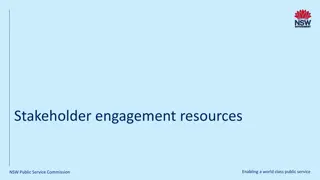Understanding the Criminalization of Coercive Control in NSW
Explore the legal implications and elements of the newly introduced offence of coercive control towards intimate partners in New South Wales. Delve into the course of conduct model, the intentions behind the behaviour, and the potential impact on victims. Learn from legal experts about prosecuting and defending cases involving coercive control.
Download Presentation

Please find below an Image/Link to download the presentation.
The content on the website is provided AS IS for your information and personal use only. It may not be sold, licensed, or shared on other websites without obtaining consent from the author. Download presentation by click this link. If you encounter any issues during the download, it is possible that the publisher has removed the file from their server.
E N D
Presentation Transcript
Legal Aid NSW Criminal Law Conference 2024 Coercive control: Defending and prosecuting the new abusive behaviour towards intimate partners offence A panel Crimes Legislation Amendment (Coercive Control) Act 2022 Madeleine Avenell SC, NSW Deputy Senior Public Defender Michelle England, A/Deputy Director NSW Director of Public Prosecutions Hayley Dean, Solicitor Advocate Legal Aid NSW 1
Why Criminalise Coercive Control? Course of conduct over incident model Expanded concept of Domestic violence Studies of lived experience Gender drivers Statistics 2
The Elements of the offence s54D of the Act (1) An adult commits an offence if (a) the adult engages in a course of conduct against another person that consists of abusive behaviour, and (b) the adult and other person are or were intimate partners, and (c) the adult intends the course of conduct to coerce or control the other person, and 3
Elements of the offence s54D of the Act (d) a reasonable person would consider the course of conduct would be likely, in all the circumstances, to cause any or all of the following, whether or not the fear or impact is in fact caused (i) fear that violence will be used against the other person or another person, or (ii) a serious adverse impact on the capacity of the other person to engage in some or all of the person s ordinary day-to-day activities. Maximum penalty Imprisonment for 7 years. 4
The Elements of the offence s54D of the Act (2) For subsection (1)(a) (a) the course of conduct may be constituted by any combination of abusive behaviours, and (b) whether the course of conduct consists of abusive behaviour must be assessed by considering the totality of the behaviours. 5
Definition Added Crimes (Domestic & Personal Violence) Act: s. 6A: definition of domestic abuse 6
Definitions within the Act Intimate partner 54C Abusive behaviour s54F Course of Conduct s54G Married or defacto, without need for a sexual relationship and can include when relationship has ended Violence Causes harm to another Shames, humiliates Threatens Destroys property Harasses or Monitors Intimidates Economic / financial abuse Isolation, denies liberty Either repeatedly or continuously Both repeatedly or continuously Does not have to be in an unbroken succession or all inside NSW. 7
Intention to Coerce or Control the adult intends the course of conduct to coerce or control the other person s. 54D(c) the intention element attaches to the course of conduct , not the abusive behaviours that make up the course of conduct proof of intention: eg inferences, admissions, s. 66A Evidence Act 1995 NOT recklessness; NOT or an intention to cause the victim/survivor harm 8
Procedural Requirements - s54H Does not affect the common law in relation to double jeopardy Particulars of the offending Standard of proof for the trier of fact 9
Statutory Defence s54E It is a defence if the course of conduct was reasonable in all the circumstances 10
Prosecution Practice Elections Negotiations Form 1s and s166 Certificates Particularised charges vs Course of conduct charges 11
Sentencing and Penalties Domestic violence offence : s. 11 of the Crimes (Domestic and Personal Violence) Act Course of conduct offence impact on risk of reoffending Max penalty: 7 yrs imprisonment Table 1 offence 12
Scenario 1 : Jane and John Early on in their relationship, John wanted Jane to get a different job that didn t involve night shifts so that she would be at home more. Jane didn t want to quit her job, but John stopped driving her to work and she was fired. From then, Jane was expected to do all the housework and John constantly criticised her efforts. John would get upset if Jane went to see family or friends. He would call her constantly throughout the day to check on her whereabouts. Eventually, Jane got a new job, but John demanded all wages be paid into a joint account. John kept asking Jane to quit her job again. One day they had a big argument about Jane working and police attended. Jane said John had physically restrained her to stop her leaving the house. She made a statement and John was charged with abusive behaviour. John instructs his lawyer that: Jane was hitting herself around the head so he put her in a bear hug to calm her down. o He never didn't want her to work he was concerned about the working conditions at her jobs. o They had an agreement for her to be at home and for him to control finances. He says this was for her own benefit because in the past she has had a gambling problem. o He denies trying to isolate her. o 13
Scenario 2 : Alex and Casey Alex and Casey had been together for 5 years, and they have 2 young children together. Alex has no criminal history and there have been no previous AVOs. They live in a small town on a rural property. Alex is a well-respected farmer. He has a firearms license. Early on in their relationship, Alex choked Casey and threatened to shoot her. This was never reported to police. After that incident, Casey would often wake up in the night and Alex would have his hand near her throat. Alex often talked about guns. Casey left the property with the children with the help of a refuge. She refuses to allow Alex see the children. Alex send Casey texts saying return the children to me now or else and everyone in this town is going to know what kind of mother you are. Family law proceedings are now on foot. Alex instructs his lawyer that: o This is all about custody of the kids she wants full custody and is financially motivated. o The only thing he admits are the texts, and he says he sent these because he was angry and devastated about not seeing the children. o He says she has serious mental health issues, that she is lying and he wants to subpoena her medical records. Police rely on: the complainant s statement, and screen shots from the Empoweryou app. The accused is found guilty after hearing and wants to make a s 14 application on the basis of diagnoses of depression and anxiety. 14
Scenario 3 : Ryan and Claire Ryan has a lengthy criminal history, including domestic violence offences against former partners. In relation to an incident in 2023, he has been charged with: sexual assault, choking and AOABH. He is also charged with abusive behaviour, based on the following conduct towards Claire from 1 July 2024: Damage to property. Threats to self-harm. Demanding money from her to buy drugs. Stealing money and wanting to sell pictures of her naked. Name-calling. Cutting up her clothes. Since Ryan has been charged, Claire had he has approached the police on two occasions seeking to withdraw her statement. She has tried to contact Ryan s lawyer too. Ryan shows his lawyer texts from her saying I never wanted things to end up like this. 15
Cases and Further Reading UK R v Conlon [2018] 1 cr. App. R (S.) 38 Legal Aid NSW Training Resource and podcast series on Coercive Control can be publicly found at; www.legalaid.nsw.gov.au/forlawyers/resources- and-tools/coercivecontrol R v Brown [2021] EWCA Crim 126 R v Chilvers [2021] EWCA Crim 1311 notable case R v Kingswell [2022] EWCA Crim 814 R v Jeffries [2023] EWCA Crim 21 Scottish Procurator Fiscal, Livingstone v H (J) 2021 S.L.T (Sch Ct) 415 HM Advocate v B (L) [2022] HCJAC 48 Walker (Scotland) v Procurator Fiscal, Dunoon [2022] SAC (Crim) 9 notable case Tasmanian Howe v S [2013] TASMC 33 Police v Benjamin James Nunn [2021] TASMC 3 notable case 16
